Click On Image
For Full Size | Size | Image Description | Source |
|---|
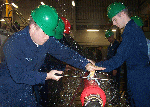 | 319k | Aviation Ordnanceman Airman Recruit Brian Gonzales from San Jose, Calif., saws a wooden wedge to plug a broken pipe during a wet-trainer exercise aboard the simulated ship Buttercup, a training facility used at Naval Station Norfolk, 26 February 2003, to assist in the training of Sailors on how to save a ship during an enemy attack. | USN photo # N-1711I-001, by Signalman 3rd Class Derrick M. Ingle, courtesy of news.navy.mil.
|
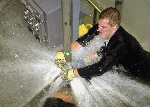 | 285k | Sailors practice repairing leaks in the "wet trainer" on board the Submarine Training Facility (SUBTRAFAC) in Norfolk, Va. 8 March 2004. The trainer is designed to test the teamwork and damage control capabilities for crews preparing to deploy aboard submarines. Sailors are exposed to leaks from pressurized service pipes within an enclosed space, in effort to provide a controlled yet realistic training environment. | USN photo # N-0000P-002, courtesy of news.navy.mil.
|
 | 322k | Interior Communications Electrician 1st Class Michael Zullo, top left, instructs Navy Junior Reserve Officer Training Corps (NJROTC) students from Chugiak High School on basic damage control procedures in the Afloat Training Group, Middle Pacific's wet trainer aboard Naval Station Pearl Harbor, Hawaii, 8 April 2004. | USN photo # N-3019M-001 by Journalist Seaman Ryan C. McGinley, courtesy of news.navy.mil.
|
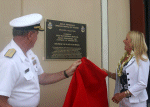 |
256k |
Commander Submarine Force, U.S. Pacific Fleet (COMSUBPAC) and Naval Submarine Training Center Pacific (NAVSUBTRACEN) dedicated the NAVSUBTRACEN Damage Control Wet Trainer in honor of Chief Electrician's Mate John D. Rendernick on 17 August 2004 at the trainer on Ford Island.
"It's such an overwhelming honor to be here," said Mary Kay Rendernick, daughter of John Rendernick. "I got the call that this event was going to take place and tears came from my eyes. I could not believe Dad was being recognized for something. He was a very secretive man in his day and he did not talk about being in the military too often," she said.
Rear Adm. Paul F. Sullivan was the guest speaker. He thanked everyone that coordinated the event and made brief remarks about Rendernick.
"This is a great occasion to honor a man of courage and a true patriot and really exemplifies what a chief petty officer is all about. Rendernick was definitely a chief petty officer and a true submariner," said Sullivan.
COMSUBPAC Force Master Chief Michael Benko feels Rendernick is important to not only naval history, but to the chief petty officer heritage.
"I think this ceremony was very fitting. It is the officers who take the ship into battle, but it is the chief petty officers that run the ship. We are witnesses today to Chief Rendernick and his efforts to lead his men in saving Billfish (SS-286)," said Benko.
Rendernick's daughter spoke on her father's behalf and expressed the importance of the dedication.
"I am amazed that he was chosen. If he were alive today, he would be overwhelmed. He said the submarine force is unique and unlike any other job. He called the old submarines "cigars under the sea." My father was not a man to cry, but there would be some tears sneaking by," she concluded.
Rendernick was awarded the Navy Silver Star for heroic actions while serving on board Billfish during the war patrol in the enemy controlled waters of Makassar Strait on 11 November 1943.
An enemy depth charge caused damage to the submarines internal piping and hull fittings. Continuous attacks added major damage to all systems and important equipment threatening the submarine's survivability.
Rendernick took action from his battle station at the electrical control cubicle aft and immediately began leading emergency repairs to reduce the heavy flooding through the stern tubes and to restore operability to damaged equipment.
He directed damage control measures aft, including pumping grease into the worst leaking stern tube and used six men and a hydraulic jack to reposition the port main motor, which had been knocked off its foundation by the shock of some extremely close depth charges. When the increasing pressure and heat reached the limit of the crew's tolerance, Rendernick had them wrap wet towels around their heads and take turns going into the livable adjacent compartment for a rest.
|
USN photo # N-5539C-007 by Journalist 3rd Class Corwin Colbert, courtesy of news.navy.mil. |
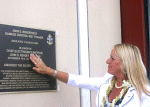 |
162k |
Mary Kay Rendernick, daughter of the WW II hero Chief Electrician's Mate John D. Rendernick reacts to the unveiling of the plaque bearing her father's name, on the Damage Control Wet Trainer at Pearl Harbor on 17 August 2004. Rendernick lead his crew aboard the Balao-class submarine Billfish (SS-286) in repairing severe internal damage during a WWII patrol, after she was struck by multiple depth charges. |
USN photo # N-5539C-004 by Journalist 3rd Class Corwin Colbert, courtesy of news.navy.mil. |
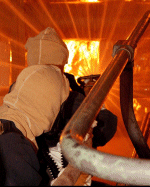 |
173k |
It may have changed over the years since Robert Nelson Norford, F1/C, USNR was lost on the Escolar (SS-294), but at Groton, Conn. on 17 September 2004, two Sailors assigned to Basic Enlisted Submarine School (BESS), battle a simulated fire in the fire fighting trainer on board Naval Submarine School, Groton, Conn. BESS incorporates basic submarine knowledge for future fleet submariners. |
USN photo # N-0000X-001 by Marion Snipes, courtesy news.navy.mil. |
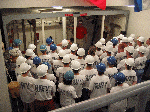 | 263k | Boston area Naval Reserve Officer Training Corps (NROTC) members listen to a briefing at the Buttercup damage control wet trainer at Naval Station Newport, R.I., during Midshipmen Orientation, 24 September 2004. Buttercup is a mock ship that sits in an 80,000-gallon tank of water with seven compartments. Students learn to work as a team and how to save the ship from a casualty. | USN photo # N-0000B-001, by Midshipmen 2nd Class Jonathan Buckingham, courtesy of news.navy.mil. |
 | 342k | Sailors from various ships stationed at Naval Station Norfolk, Va., practice damage control procedures while preparing to patch a leaking pipe aboard training simulator Buttercup, 25 July 2005. | USN photo # N-6639M-173, by Photographer's Mate 3rd Class Laura A. Moore, courtesy of news.navy.mil.
|
 | 454k | Students learn how to patch a pipe under simulated conditions at the Center for Naval Engineering Damage Control, Buttercup trainer on board Naval Station Norfolk, 16 November 2005. The drills performed aboard Buttercup simulate very closely to damage control situations that can occur on ships at sea. | USN photo # N-3541A-003, by Journalist Seaman Davis J. Anderson, courtesy of news.navy.mil.
|
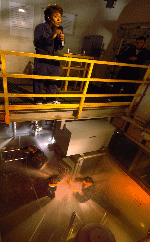 | 259k | Good Morning America's host Robin Roberts goes "live on air" from the Damage Control Wet Trainer at Submarine Learning Facility on board Naval Station Norfolk, 22 November 2005. Submarine Learning Facility provides basic and advanced individual training and unit level instruction designed for the qualification and certification necessary of the officers and enlisted in the submarine, surface and aviation communities. | USN photo # N-6639M-001 by Photographer's Mate 3rd Class Laura A. Moore, courtesy of news.navy.mil.
|
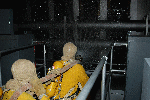 | 600k | Machinist's Mate 2nd Classes Marcelo Valencia and Scott Newton assigned to Naval Submarine Training Command Pacific (NSTCP) use a Navy standard fire hose with the vari-nozzle attachment to put a fire out during fire fighting training on Ford Island, Hawaii, 25 April 2006. NSTCP provides damage control training for all submarines stationed at Pearl Harbor and offers six different damage control related courses. | USN photo # N-4856G-024 by Photographer's Mate 3rd Class Ben A. Gonzales, courtesy of news.navy.mil. |
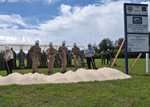 | 420k | Naval Facilities Engineering Command (NAVFAC) Marianas, Commander, Submarine Squadron (COMSUBRON) 15, and Dck Pacific Guam leadership and representatives shovel sand at the groundbreaking ceremony at Polaris Point for a two-story consolidated training submarine learning center and headquarters facility and a one-story torpedo exercise support facility for COMSUBRON-15 in Piti, Guam on 15 July 2010. | USN photo # N-8433N-887 by Oyaol Ngirairikl, courtesy of news.navy.mil. |
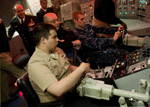 | 271k | Missile Technician 3rd Class Ricardo Martinez, left, Senior Chief Missile Technician Chad Wright and Machinist's Mate Fireman Michael Ford, all assigned to the Ohio-class ballistic-missile submarine Alaska (SSBN 732), operate the controls of the dive simulator at the Trident Training Facility on 1 March 2011 at Kings Bay, GA. Rear Adm. Piero Fagadini Gonzalez, in background, Naval and Defense Attache' to the Chilean Embassy, a Chilean submariner, was on a visit to the training facility. | USN photo # N-FG395-019 by Mass Communication Specialist 1st Class James Kimber, courtesy of news.navy.mil.
|
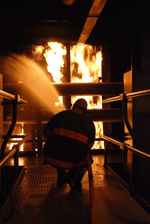 | 771k | Machinist's Mate 1st Class Patrick Demaris, a Groton Conn. Naval Submarine School instructor, uses a fire hose to demonstrate fighting a submarine hull fire during a controlled burn training scenario in the school's fire fighting trainer on 22 March 2011. | USN photo # N-5188B-121 by Mass Communication Specialist 1st Class Peter D. Blair, courtesy of news.navy.mil. |













